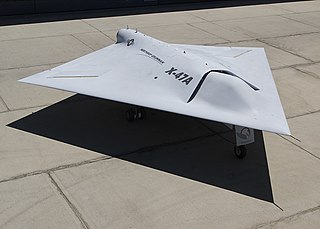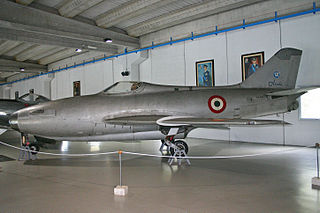Related Research Articles

The Northrop Grumman X-47 is a demonstration unmanned combat aerial vehicle. The X-47 began as part of DARPA's J-UCAS program, and is now part of the United States Navy's UCAS-D program to create a carrier-based unmanned aircraft. Unlike the Boeing X-45, initial Pegasus development was company-funded. The original vehicle carries the designation X-47A Pegasus, while the follow-on naval version is designated X-47B.

The Dassault nEUROn is an experimental unmanned combat aerial vehicle (UCAV) being developed with international cooperation, led by the French company Dassault Aviation. Countries involved in this project include France, Greece, Italy, Spain, Sweden and Switzerland. The design goal is to create a stealthy, autonomous UAV that can function in medium-to high-threat combat zones. Comparable projects include the British BAE Systems Taranis, German/Spanish EADS Barracuda, American Boeing X-45 and Northrop Grumman X-47B, the Indian DRDO AURA, and the Russian Mikoyan Skat and Sukhoi Okhotnik.

The Sikorsky Cypher and Cypher II are types of unmanned aerial vehicles developed by Sikorsky Aircraft. They are vertical takeoff and landing aircraft which use two opposing rotors enclosed in a circular shroud for propulsion.

The Bell Helicopter Eagle Eye, Model 918, was an American tiltrotor unmanned aerial vehicle that was offered as one of the competitors in the United States Navy's VT-UAV program.

The Aerfer Ariete was a prototype fighter aircraft built in Italy in 1958. It was a refined derivative of the Aerfer Sagittario 2, and was an attempt to bring that aircraft up to a standard where it could be mass-produced as a viable combat aircraft.

The Piaggio PD.808 was an Italian business jet built by Piaggio. It was designed as a joint venture between Piaggio and Douglas Aircraft Company of Long Beach, California, United States.

The EADS Barracuda is a jet powered European unmanned aerial vehicle (UAV) currently under development by EADS, intended for the role of aerial reconnaissance and also combat (UCAV). The aircraft is a joint venture between Germany and Spain.

The Boeing YQM-94 B-Gull was a developmental aerial reconnaissance drone developed by Boeing. It could take off and land from a runway like a manned aircraft, and operate at high altitudes for up to 24 hours to perform aerial surveillance, communications relay, or atmospheric sampling.

The Tupolev Tu-141 Strizh is a Soviet reconnaissance drone that served with the Soviet Red Army during the late 1970s and 1980s.

The Fiat G.80 was a military jet trainer developed in Italy in the 1950s, and was that country's first true jet-powered aircraft. It was a conventional low-wing monoplane with retractable tricycle undercarriage and engine air intakes on the fuselage sides. The pilot and instructor sat in tandem under a long bubble canopy.
The Teledyne Ryan BQM-145 Peregrine is a reconnaissance unmanned aerial vehicle (UAV) developed in the United States in the 1990s as a joint U.S. Navy/Marine Corps and Air Force "Medium Range UAV" program, with the Navy developing the airframe and the Air Force providing the payload. The BQM-145A was designed to precede airstrike packages into a target area and relay reconnaissance information in real time.
The Mirach 150 is a reconnaissance unmanned aerial vehicle (UAV) developed in Italy in the 1990s. A turbojet-powered machine, it is apparently a derivative of the Mirach 100 series of targets, being of the same general size and also powered by a Microturbo TRS-18-1 turbojet.

The Ryan YQM-98 R-Tern was a developmental aerial reconnaissance drone developed by Ryan Aeronautical. It could take off and land from a runway like a manned aircraft, and operate at high altitudes for up to 24 hours to perform surveillance, communications relay, or atmospheric sampling.

The Alenia Aeronautica Sky-X is a self-financed Unmanned combat air vehicle for demonstration and research purpose; on May 29, 2005 it became the first European-designed UAV in the over 1000 kg category to fly with success.
The Microturbo TRI-40 is a small turbojet engine developed for use in cruise missiles and small unmanned aerial vehicles in the 2.2 - 3.6 kN thrust class.

The Microturbo TRI 60 is a small, expendable turbojet engine developed for use in cruise missiles, target drones, and other small unmanned air vehicles. Variants of this engine produce from 3.5 - 5.3 kN of thrust. The engine first ran in 1974.

The Italian Alenia Aeronautica Sky-Y is a self-financed MALE Unmanned air vehicle for demonstration and research purpose; on 30 October 2007 it set a new European endurance record in the over 1000 kg category with a spotless eight-hour flight. Since 2016 manufacturer became Leonardo-Finmeccanica as Alenia Aermaccchi merged into the new Finmeccanica.
The EFF Prometheus was an unusual two seat motor glider powered by a pair of small turbojet engines, designed and constructed in Switzerland in the 1970s. Two versions with different spans were built, but it did not go into production.

AirStrato is a solar powered medium-sized unmanned aerial vehicle that was being developed by ARCAspace. There were two variants planned, AirStrato Explorer with a target flight ceiling of 18,000 m and AirStrato Pioneer with a target flight ceiling of 8000 m. It was planned to carry a 45 kg payload consisting of surveillance equipment, scientific instruments or additional battery pods for extended autonomy. The first prototype maiden flight took place on February 28, 2014. It was equipped with a fixed landing gear. Two more prototypes were constructed that lacked a landing gear. Instead ARCA opted for a pneumatic catapult as a launcher and landing skids and a recovery parachute for landing. Both prototypes performed take-off and landing testing and low altitude flights.
The Composite Engineering BQM-167 Skeeter is a subscale aerial target (drone) developed and manufactured by Composite Engineering Inc. and operated by the United States Air Force and certain international customer air forces. It has replaced the Beechcraft MQM-107 Streaker.
References
This article contains material that originally came from the web article Unmanned Aerial Vehicles by Greg Goebel, which exists in the Public Domain.
| This article on an unmanned aerial vehicle is a stub. You can help Wikipedia by expanding it. |